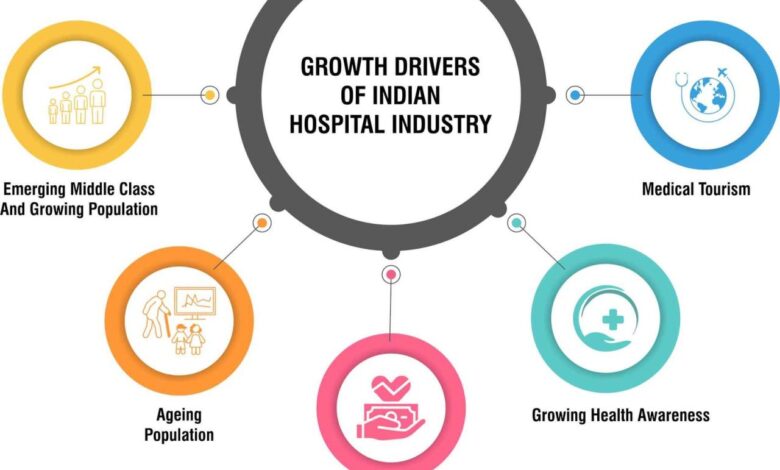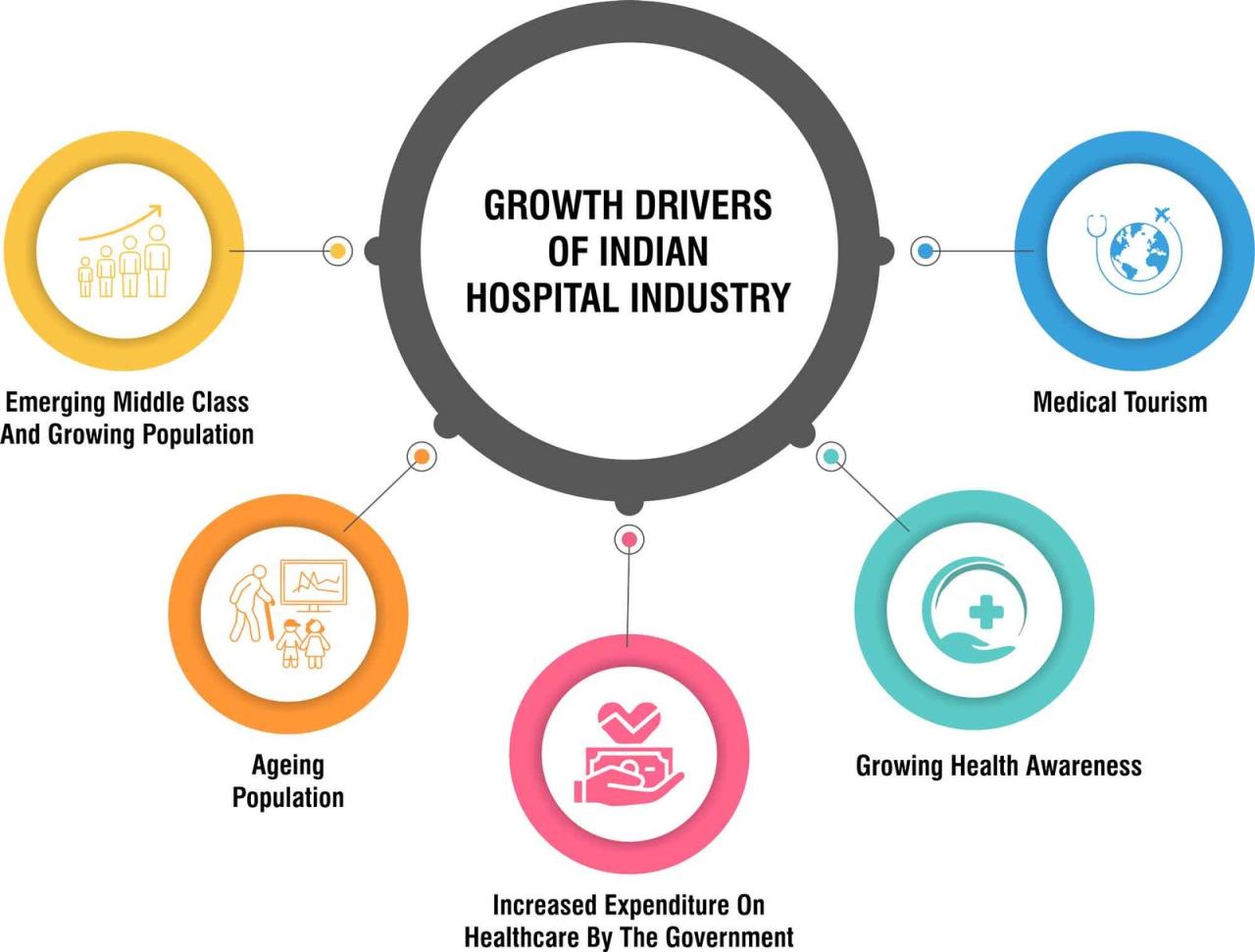
Key Healthcare Hospital Provider Trends Now
Key healthcare hospital provider trends are rapidly reshaping the landscape of patient care and hospital operations. From the rise of telehealth and AI-powered diagnostics to the increasing focus on value-based care and data analytics, the healthcare industry is undergoing a period of unprecedented transformation. This evolution presents both significant challenges and exciting opportunities for hospitals and healthcare providers, demanding adaptation and innovation to meet the evolving needs of patients and the healthcare system as a whole.
We’ll explore these pivotal shifts and their implications.
This post delves into the key forces driving change, examining the impact of technological advancements, shifting healthcare models, the crucial role of data, the influence of demographics, financial sustainability concerns, cybersecurity threats, and the ever-growing importance of patient experience. We’ll look at specific examples, challenges, and opportunities to provide a comprehensive overview of this dynamic field.
Technological Advancements in Healthcare: Key Healthcare Hospital Provider Trends
The healthcare landscape is undergoing a dramatic transformation, driven by rapid technological advancements. These innovations are not only improving the quality of care but also enhancing efficiency and accessibility for both patients and providers. This section will explore some key technological advancements shaping the future of hospital services.
Telehealth’s Impact on Hospital Provider Services and Patient Access
Telehealth has revolutionized healthcare delivery, expanding access to care, particularly for patients in rural or underserved areas. Video conferencing, remote patient monitoring, and online portals allow for virtual consultations, reducing the need for in-person visits. This has eased the burden on hospital resources, enabling providers to see more patients and manage chronic conditions more effectively. For example, a patient with hypertension can have their blood pressure monitored remotely, allowing for timely intervention and preventing potential hospitalizations.
The increased convenience for patients also leads to improved adherence to treatment plans.
The Role of AI and Machine Learning in Improving Diagnosis and Treatment
Artificial intelligence (AI) and machine learning (ML) are rapidly transforming diagnostic and treatment processes. AI algorithms can analyze medical images (X-rays, CT scans, etc.) with remarkable accuracy, assisting radiologists in detecting anomalies like tumors or fractures. ML models can predict patient risk factors for certain diseases, allowing for proactive interventions. For instance, an AI system might identify patients at high risk of developing heart failure, prompting earlier preventative measures.
Key healthcare hospital provider trends are constantly shifting, with financial stability a major concern. The recent news about Steward Health Care securing financing to emerge from bankruptcy, as reported by this article , highlights the precarious financial landscape many providers face. This underscores the need for innovative financial models and operational efficiencies within the evolving healthcare system.
This leads to more accurate diagnoses, personalized treatment plans, and ultimately, better patient outcomes.
Electronic Health Records (EHRs) and Streamlined Hospital Operations
The implementation of electronic health records (EHRs) has significantly streamlined hospital operations. EHRs provide a centralized, digital repository of patient medical information, accessible to authorized healthcare providers. This eliminates the need for paper charts, reducing errors and improving the efficiency of information sharing. EHRs also facilitate better coordination of care among different healthcare professionals involved in a patient’s treatment.
The automation of administrative tasks, such as appointment scheduling and billing, further enhances efficiency and reduces operational costs. Furthermore, the data stored in EHRs can be used for research purposes, contributing to advancements in medical knowledge and treatment strategies.
Comparison of Telehealth Platforms
The effectiveness of telehealth relies heavily on the chosen platform. Different platforms offer varying features and capabilities. Below is a comparison of some common telehealth platforms:
| Platform | Advantages | Disadvantages | Cost |
|---|---|---|---|
| Video Conferencing (e.g., Zoom, Skype) | Easy to use, widely accessible, relatively inexpensive. | Limited features, security concerns, may lack integration with EHRs. | Low to Moderate |
| Dedicated Telehealth Platforms (e.g., Teladoc, MDLive) | Secure, HIPAA compliant, integrated features (e.g., e-prescribing, messaging). | Higher cost, may require subscriptions or per-visit fees. | Moderate to High |
| Remote Patient Monitoring (RPM) Devices | Continuous data collection, proactive intervention, improved patient engagement. | Requires patient adherence, potential for technical issues, data privacy concerns. | Moderate to High |
| Hospital-Specific Portals | Seamless integration with EHRs, personalized patient experience. | Limited accessibility outside the hospital network. | Moderate to High |
Shifting Healthcare Models
The healthcare landscape is undergoing a dramatic transformation, moving away from traditional fee-for-service models towards value-based care. This shift is driven by a need for greater efficiency, improved patient outcomes, and a more sustainable healthcare system. Hospitals are adapting to these changes by embracing new payment models, focusing on preventative care, and collaborating with community partners to improve population health.The rise of value-based care fundamentally alters how hospitals are reimbursed.
Instead of simply billing for each service provided, reimbursement is increasingly tied to the overall quality and cost-effectiveness of care. This incentivizes hospitals to focus on preventing illness, managing chronic conditions effectively, and improving patient outcomes. This transition requires significant changes in hospital operations, including investments in data analytics, care coordination, and patient engagement strategies.
Value-Based Care and Hospital Reimbursement
Value-based care emphasizes providing high-quality care at a lower cost. Hospitals are rewarded for achieving better patient outcomes and reducing unnecessary spending. Traditional fee-for-service models, where providers are paid for each individual service rendered, often incentivize volume over value. In contrast, value-based care models, such as bundled payments and accountable care organizations (ACOs), reward providers for keeping patients healthy and managing their care effectively.
For example, a hospital might receive a bundled payment for a hip replacement, encompassing all services from pre-operative assessment to post-operative rehabilitation. Their reimbursement depends on the overall cost-effectiveness and patient satisfaction associated with that care episode. Failing to manage costs or achieve positive patient outcomes could lead to reduced payments.
Preventative Care and Population Health Management
Preventative care and population health management are gaining prominence as key components of a value-based system. Hospitals are increasingly investing in programs designed to identify and address health risks before they escalate into costly and complex medical interventions. This includes initiatives such as health screenings, wellness programs, and chronic disease management. Population health management focuses on improving the health of entire communities, rather than treating individuals in isolation.
This involves using data analytics to identify high-risk populations, tailoring interventions to their specific needs, and coordinating care across multiple providers. For instance, a hospital might partner with local community centers to offer free blood pressure screenings and diabetes education programs. This proactive approach can prevent costly hospitalizations and improve the overall health of the community.
Fee-for-Service vs. Alternative Payment Models
Traditional fee-for-service models, where providers are paid for each service rendered, contrast sharply with alternative payment models. Fee-for-service incentivizes volume, potentially leading to unnecessary tests and procedures. Alternative payment models, on the other hand, focus on value and often involve shared savings or bundled payments. Examples of alternative payment models include accountable care organizations (ACOs), bundled payments, and capitation.
ACOs are groups of doctors, hospitals, and other healthcare providers who work together to coordinate care for Medicare patients. Bundled payments cover all services related to a specific episode of care, while capitation involves paying providers a fixed amount per patient per month. The success of these models hinges on effective care coordination, data-driven decision-making, and a focus on patient outcomes.
Successful Hospital Partnerships with Community Health Organizations
Successful hospital partnerships with community health organizations demonstrate the power of collaboration in improving population health. These partnerships often involve sharing resources, expertise, and data to address the unique health needs of specific communities. For example, a hospital might partner with a local community health clinic to provide access to primary care services in underserved areas. Another example could involve a collaboration with a non-profit organization to offer health education programs and support services for patients with chronic conditions.
These partnerships can significantly improve access to care, reduce health disparities, and enhance the overall health of the community. A successful partnership often requires a shared vision, clear communication, and a commitment to collaboration from all stakeholders.
The Growing Importance of Data Analytics

Source: asianhhm.com
Hospitals are increasingly recognizing the transformative power of data analytics to enhance patient care and streamline operations. The sheer volume of data generated daily – from electronic health records (EHRs) to medical devices and patient portals – presents an unprecedented opportunity to gain valuable insights that were previously inaccessible. By leveraging advanced analytical techniques, hospitals can move beyond reactive care to proactive, data-driven decision-making.Data analytics empowers hospitals to improve patient outcomes and operational efficiency in several key ways.
For example, analyzing patient data can identify trends and patterns associated with specific diseases, leading to more effective treatment strategies and improved patient safety protocols. Analyzing operational data, such as bed occupancy rates and staffing levels, can optimize resource allocation and reduce costs. Furthermore, predictive modeling based on historical data allows hospitals to anticipate future needs and proactively address potential challenges.
Predictive Modeling for Readmission Risk
Predictive modeling plays a crucial role in identifying patients at high risk for readmission. By analyzing factors such as age, diagnosis, length of stay, medication adherence, and social determinants of health, sophisticated algorithms can predict the likelihood of a patient being readmitted within a specific timeframe, typically 30 days. For instance, a model might flag patients with congestive heart failure who have a history of non-compliance with medication regimens as being at high risk.
This allows healthcare providers to intervene proactively with targeted interventions such as home healthcare visits, medication reconciliation, and enhanced patient education, thus reducing readmission rates and improving overall patient outcomes. A successful implementation of such a model in a large urban hospital system demonstrated a 15% reduction in 30-day readmissions for heart failure patients within the first year.
A Data Visualization Dashboard for Hospital Operations
A comprehensive data visualization dashboard could provide a real-time overview of key performance indicators (KPIs) for hospital operations. This dashboard might include modules displaying:
- Patient Flow: Real-time bed occupancy rates, emergency department wait times, and average length of stay, visualized through interactive charts and maps.
- Financial Performance: Revenue cycle metrics, such as accounts receivable days and operating margins, presented as dynamic graphs.
- Staffing Levels: Nurse-to-patient ratios, physician availability, and overtime hours, illustrated using heatmaps and trend lines.
- Quality Metrics: Infection rates, readmission rates, and patient satisfaction scores, displayed as comparative charts and progress indicators.
- Supply Chain Management: Inventory levels, supply costs, and equipment utilization, visualized using bar charts and pie charts.
Such a dashboard would provide hospital administrators with a clear and concise overview of operational performance, enabling data-driven decision-making to optimize resource allocation, improve efficiency, and enhance patient care.
Ethical Considerations in Healthcare Analytics
The use of patient data in healthcare analytics raises several important ethical considerations. Protecting patient privacy and confidentiality is paramount. Compliance with regulations like HIPAA (Health Insurance Portability and Accountability Act) is crucial, ensuring that data is anonymized or de-identified appropriately before being used for analytical purposes. Transparency regarding data collection and usage practices is also vital, with patients needing to be fully informed about how their data is being used and having the ability to opt out if they choose.
Furthermore, the potential for bias in algorithms and the need for fairness and equity in the application of analytical models must be carefully considered to prevent discrimination and ensure equitable access to care. The responsible and ethical use of patient data is critical to maintaining public trust and ensuring the integrity of healthcare analytics.
The Impact of the Changing Demographics
The global population is aging, and this demographic shift presents both unprecedented challenges and exciting opportunities for the healthcare industry. Hospitals are facing increased demand for services tailored to older adults, while simultaneously navigating the complexities of managing a growing prevalence of chronic diseases and serving increasingly diverse patient populations. Adapting to these changes requires strategic planning, innovative solutions, and a commitment to providing equitable, high-quality care.
The aging population, coupled with advancements in medical technology extending lifespans, is placing significant strain on healthcare resources. The increasing number of individuals living with multiple chronic conditions like diabetes, heart disease, and dementia requires more intensive and long-term care, impacting hospital bed availability, staffing levels, and overall budgetary constraints. This necessitates a shift towards preventative care, improved care coordination, and a focus on managing chronic conditions effectively to reduce hospital readmissions and improve overall patient outcomes.
The Challenges of an Aging Population
An aging population presents numerous challenges for hospitals. The increasing prevalence of age-related conditions such as dementia, osteoarthritis, and cardiovascular disease leads to a higher demand for specialized geriatric care, including rehabilitation services, long-term care facilities, and palliative care. The need for more geriatricians and specialized healthcare professionals is acute, and the current workforce may not be adequately prepared to meet this rising demand.
Furthermore, the financial burden of caring for an aging population can strain hospital budgets, necessitating innovative funding models and cost-effective care delivery strategies. For example, the rising cost of Alzheimer’s disease care alone is projected to place immense pressure on healthcare systems globally in the coming decades.
The Increasing Prevalence of Chronic Diseases
The rising prevalence of chronic diseases significantly impacts hospital resources. Chronic conditions often require ongoing management, leading to increased hospital admissions, longer lengths of stay, and a greater need for specialized care. This places a strain on hospital beds, staffing, and equipment. For instance, the increasing number of patients with diabetes often requires specialized care for complications like diabetic foot ulcers, retinopathy, and nephropathy, demanding more resources than patients with acute conditions.
Hospitals must invest in strategies to prevent hospital readmissions for chronic disease patients, such as enhanced discharge planning, improved patient education, and robust follow-up care.
The Need for Culturally Competent Healthcare Services
Hospitals must provide culturally competent care to effectively serve diverse patient populations. This involves understanding and respecting the unique cultural beliefs, practices, and communication styles of patients from different backgrounds. Failure to do so can lead to communication barriers, mistrust, and poorer health outcomes. For example, providing health information in multiple languages and incorporating culturally sensitive approaches to patient care can significantly improve patient engagement and satisfaction.
Hospitals should recruit and retain a diverse workforce that reflects the communities they serve, ensuring that patients feel understood and respected.
Strategies to Address the Needs of an Aging Population
Hospitals can adopt several strategies to address the needs of an aging population. These include:
Implementing proactive strategies for preventing chronic diseases through health promotion and disease prevention programs is crucial. Early detection and intervention can significantly reduce the burden on hospital resources. This could involve community outreach programs focusing on healthy lifestyle choices, regular screenings, and timely access to primary care. Investing in telehealth and home-based care can also reduce hospital readmissions and improve patient outcomes.
For example, remote monitoring of patients with chronic conditions can allow for early detection of potential problems and timely interventions, reducing the need for hospital visits.
Key healthcare hospital provider trends show a growing focus on preventative care, a crucial aspect highlighted by the recent news of Monali Thakur’s hospitalization; check out this article on her experience and how to prevent respiratory diseases: monali thakur hospitalised after struggling to breathe how to prevent respiratory diseases. This underscores the importance of proactive measures, a shift reflected in many hospitals’ investment in early detection and wellness programs.
Furthermore, fostering partnerships with community-based organizations, long-term care facilities, and other healthcare providers is essential for creating a seamless continuum of care. This integrated approach ensures that patients receive appropriate care at the right time and in the right setting, reducing the burden on hospitals. Hospitals should also invest in training and education for healthcare professionals to improve their knowledge and skills in geriatric care, cultural competency, and chronic disease management.
This includes providing ongoing professional development opportunities and access to updated best practices.
Key healthcare hospital provider trends are shifting towards specialized care, and this is especially vital for neurological conditions. For example, effective management of childhood conditions like Tourette Syndrome requires a multidisciplinary approach, as detailed in this helpful resource on strategies to manage Tourette syndrome in children. Understanding these specialized needs is crucial for hospitals aiming to stay at the forefront of patient care and attract families seeking the best possible treatment.
Financial Sustainability and Operational Efficiency
Hospitals today face increasing pressure to balance high-quality patient care with stringent financial constraints. Maintaining financial sustainability and achieving operational efficiency are no longer optional; they are critical for survival and continued success in the evolving healthcare landscape. This requires a multi-pronged approach focusing on revenue cycle management, cost reduction, and effective leadership.Improving hospital revenue cycle management is paramount to financial health.
Efficient processes ensure timely billing and payment collection, minimizing revenue leakage and maximizing cash flow. This involves streamlining administrative tasks, optimizing billing systems, and effectively managing patient accounts. Cost reduction initiatives are equally crucial. Hospitals can explore various strategies to reduce expenses without compromising the quality of care, including supply chain optimization, energy efficiency improvements, and the implementation of advanced technologies to improve efficiency and reduce waste.
Strong leadership is the backbone of successful operational efficiency. Effective hospital leaders foster a culture of continuous improvement, empower staff, and create a data-driven decision-making environment.
Strategies for Improving Hospital Revenue Cycle Management, Key healthcare hospital provider trends
Effective revenue cycle management hinges on several key strategies. These include implementing robust electronic health record (EHR) systems to automate processes, reducing manual data entry and improving accuracy. Pre-authorization processes should be streamlined to ensure timely approvals and minimize denials. Regular audits of billing processes and claims submissions are essential to identify and rectify errors, preventing revenue loss.
Furthermore, strong patient communication and financial counseling can improve patient understanding of billing processes and increase the likelihood of timely payments. Finally, investing in technology that automates payment processing and reconciliation can significantly improve efficiency and reduce manual effort.
The Importance of Cost Reduction Initiatives in Maintaining Financial Stability
Cost reduction is not about cutting corners; it’s about optimizing resource allocation and eliminating waste. Hospitals can leverage data analytics to identify areas of high expenditure and implement targeted interventions. Negotiating favorable contracts with suppliers can significantly reduce the cost of medical supplies and equipment. Implementing energy-efficient technologies, such as LED lighting and smart building management systems, can reduce energy consumption and associated costs.
Streamlining administrative processes, reducing paperwork, and optimizing staffing levels can also yield substantial cost savings. For example, a hospital might implement a telemedicine program to reduce the need for costly in-person visits, while simultaneously improving access to care. Such programs often yield positive ROI within a few years.
The Role of Hospital Leadership in Driving Operational Efficiency
Hospital leaders play a pivotal role in shaping a culture of efficiency and fostering a data-driven approach to decision-making. This includes establishing clear goals and metrics for operational efficiency, empowering staff to identify and implement process improvements, and fostering collaboration across departments. Investing in leadership training and development programs focused on operational excellence is crucial. Leaders must also champion the adoption of new technologies and innovative approaches to improve efficiency.
A culture of continuous improvement, supported by strong leadership, is essential for achieving long-term operational success. For instance, leaders who actively solicit feedback from staff on process inefficiencies and empower them to propose solutions will find that they can identify and solve problems much more efficiently.
Innovative Approaches to Hospital Resource Allocation
Innovative approaches to resource allocation are vital for ensuring optimal utilization and minimizing waste. This can involve using predictive modeling to forecast resource needs, optimizing bed utilization rates, and employing advanced scheduling systems to improve patient flow. Implementing just-in-time inventory management for medical supplies can reduce storage costs and minimize waste. Data-driven decision-making enables hospitals to allocate resources more effectively, based on actual needs and demand.
For example, a hospital might use predictive analytics to anticipate surges in patient volume during flu season, allowing them to proactively adjust staffing levels and resource allocation to meet the increased demand. This prevents costly overtime and ensures optimal patient care.
The Role of Cybersecurity in Healthcare
The healthcare industry, with its sensitive patient data and complex interconnected systems, is a prime target for cyberattacks. These attacks not only threaten patient privacy and the integrity of medical records but also can disrupt critical hospital operations, leading to significant financial losses and even endangering patient lives. The increasing sophistication of cyber threats necessitates a proactive and robust approach to cybersecurity, ensuring the protection of sensitive information and the resilience of healthcare systems.The Importance of Robust Cybersecurity Protocols and Data Protection MeasuresHospitals must implement comprehensive cybersecurity protocols to safeguard patient data and maintain operational integrity.
This includes a multi-layered approach encompassing network security, endpoint protection, data encryption, and regular security audits. Failure to do so can result in significant breaches, leading to hefty fines, reputational damage, and loss of patient trust. For example, the 2017 WannaCry ransomware attack crippled hospitals worldwide, demonstrating the devastating consequences of inadequate cybersecurity measures. Robust protocols, however, can mitigate the risk of such attacks and protect both patient data and hospital operations.
HIPAA Compliance and Patient Privacy Protection
The Health Insurance Portability and Accountability Act (HIPAA) sets stringent regulations for protecting patient health information (PHI). Hospitals must adhere to these regulations, which include implementing appropriate administrative, physical, and technical safeguards to ensure the confidentiality, integrity, and availability of PHI. This involves not only securing electronic health records (EHRs) but also managing paper-based records and protecting information shared with third-party providers.
Non-compliance with HIPAA can result in substantial financial penalties and legal repercussions. Effective training programs for all staff members on HIPAA regulations and security best practices are crucial to maintaining compliance.
Essential Cybersecurity Measures for Hospitals
A robust cybersecurity strategy for hospitals requires a multifaceted approach. The following checklist highlights essential measures:
Hospitals need to regularly assess their vulnerability to cyber threats. This involves identifying weaknesses in their systems and developing strategies to mitigate those risks. This should include penetration testing and vulnerability scanning to proactively identify and address potential security gaps.
- Regular security audits and vulnerability assessments
- Implementation of strong access control measures, including multi-factor authentication
- Data encryption both in transit and at rest
- Robust endpoint protection, including antivirus and anti-malware software
- Employee training on cybersecurity awareness and best practices
- Incident response plan and regular testing of the plan
- Regular software updates and patching
- Data loss prevention (DLP) measures
- Network segmentation to isolate sensitive data
- Regular backups and disaster recovery planning
These measures, when implemented effectively, significantly reduce the risk of cyberattacks and protect sensitive patient data. The investment in cybersecurity is not merely a cost, but rather a crucial investment in protecting patients, maintaining operational integrity, and ensuring the long-term sustainability of the healthcare organization.
Patient Experience and Engagement
Improving the patient experience is no longer a mere nicety; it’s a critical factor in driving patient satisfaction, loyalty, and ultimately, a hospital’s success. Positive experiences lead to better health outcomes, increased patient adherence to treatment plans, and improved hospital reputation, attracting more patients and enhancing the overall bottom line. Ignoring patient experience can lead to negative reviews, decreased referrals, and ultimately, financial losses.Patient experience encompasses the entire journey a patient undertakes, from initial contact to post-discharge follow-up.
It involves the physical environment, the interactions with staff, the clarity of information provided, and the overall feeling of being cared for and respected. A focus on patient experience fosters a culture of empathy and care within the hospital, improving the work environment for staff as well.
Innovative Approaches to Enhancing Patient Communication and Engagement
Effective communication is paramount to a positive patient experience. Hospitals are increasingly adopting innovative technologies to improve communication and engagement. This includes utilizing patient portals for secure online access to medical records, appointment scheduling, and messaging with healthcare providers. Text message reminders for appointments and medication refills enhance adherence and reduce missed appointments. Interactive kiosks in waiting rooms provide information, entertainment, and streamline check-in processes.
Furthermore, telehealth platforms allow for remote consultations, reducing travel time and improving access to care, especially for patients in rural areas or with mobility issues. For example, the Mayo Clinic uses a robust patient portal with integrated telehealth capabilities, enhancing communication and patient convenience.
Utilizing Patient Feedback to Improve Hospital Services and Processes
Patient feedback is invaluable for identifying areas for improvement and enhancing hospital services. Collecting feedback through various channels – surveys, online reviews, and comment cards – provides a comprehensive understanding of the patient experience. Analyzing this feedback helps pinpoint specific pain points, such as long wait times, unclear communication, or unsatisfactory interactions with staff. Hospitals can then implement targeted interventions to address these issues.
For instance, a hospital might discover through patient feedback that wait times in the emergency room are excessively long. This data could then be used to optimize staffing levels, improve triage processes, or implement new technologies to reduce wait times. Regularly analyzing and acting on patient feedback demonstrates a commitment to continuous improvement and shows patients that their opinions matter.
Patient Satisfaction Survey Design
A well-designed patient satisfaction survey is crucial for gathering meaningful data. The survey should be concise and easy to understand, avoiding jargon or overly technical language. Key aspects of the hospital experience to measure include:
- Waiting times in different departments (e.g., emergency room, outpatient clinics).
- Clarity of information provided by doctors and nurses.
- Friendliness and helpfulness of staff.
- Cleanliness and comfort of the facilities.
- Overall satisfaction with the care received.
- Effectiveness of pain management.
- Ease of access to information and services (e.g., patient portal).
The survey should include a mix of quantitative (e.g., rating scales) and qualitative (e.g., open-ended questions) questions to capture both objective and subjective aspects of the experience. Data collected should be analyzed regularly to track trends and identify areas needing attention. The results should be used to inform improvements in processes and services, and the feedback should be shared with staff to encourage continuous improvement.
For example, a hospital might use a 5-point Likert scale to measure patient satisfaction with various aspects of care, supplementing this with open-ended questions to gather detailed feedback on specific experiences.
Outcome Summary

Source: theglobalhues.com
The future of healthcare hinges on the ability of hospital providers to embrace these key trends and adapt their strategies accordingly. Successfully navigating the technological, financial, and demographic shifts requires a proactive and forward-thinking approach. By prioritizing innovation, data-driven decision-making, and patient-centric care, hospitals can not only ensure their own sustainability but also contribute to a healthier and more equitable healthcare system for all.
The journey is complex, but the rewards of embracing change are immense.
Question Bank
What is value-based care, and how does it differ from fee-for-service?
Value-based care focuses on improving patient outcomes and reducing costs, rewarding providers for quality of care rather than the quantity of services. Fee-for-service, in contrast, reimburses providers for each individual service rendered, potentially incentivizing more procedures rather than optimal patient care.
How can hospitals improve patient engagement?
Hospitals can improve patient engagement through proactive communication, patient portals, personalized care plans, and actively soliciting and responding to patient feedback. Creating a supportive and empathetic environment is also crucial.
What are the biggest cybersecurity threats facing hospitals today?
Hospitals face threats like ransomware attacks, data breaches, phishing scams, and insider threats. These can compromise patient data, disrupt operations, and result in significant financial losses.
How can hospitals address the needs of an aging population?
Hospitals can address this by investing in geriatric care specialists, providing accessible facilities, offering preventative care programs tailored to older adults, and incorporating technology to improve remote monitoring and care coordination.





